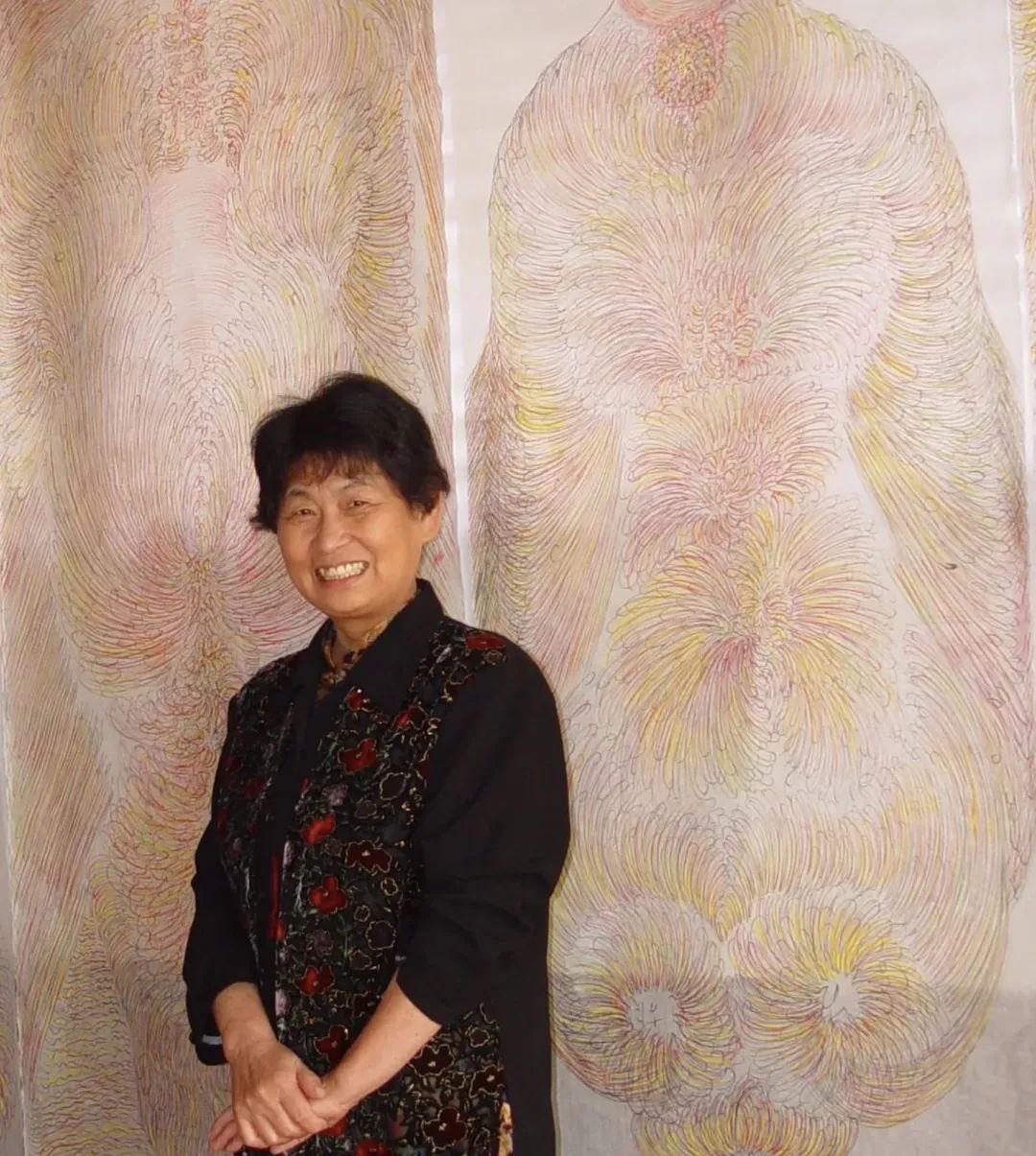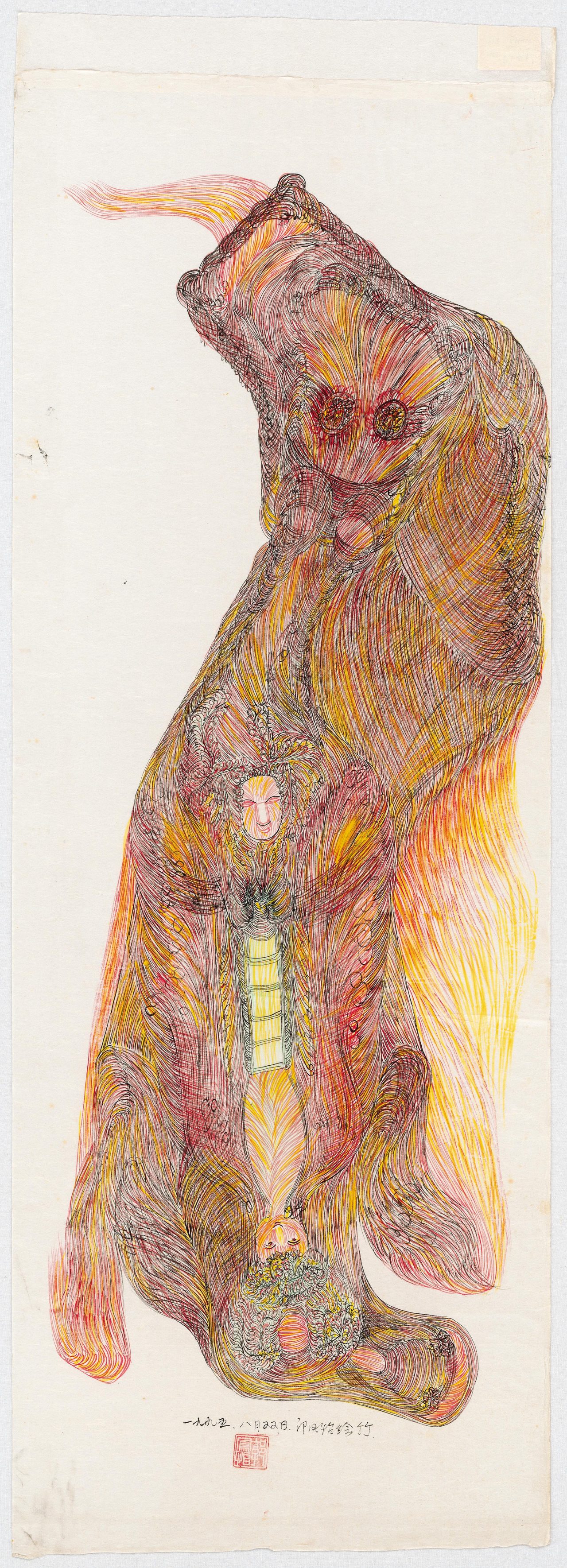The Image World of Guo Fengyi
"The images by Guo Fengyi are some of the most complex things existent. Twisting and circuitous, they stimulate a feeling of confusion creating a system strung together with riddles for meditation and mystic contemplation whose location lies beyond our ability to cartograph. What for us appears to be an unreconcilable maze, for her is an answered Zen koan. To Guo Fengyi, drawing is an internal journey within a dark and mysterious world littered with divergences, mapped through the tip of her brush, ever drawing closer to its true center, but never arriving at it. Her drawings are a continual telling of unreadable narratives. These narratives may be mutually supportive or interrelated, or they could be contradictory and oppositional, just like the thick and intricate lines of her drawings, mutually connected and mutually inclusive. What these vast interrelationships simulate is a possible world which cannot be experienced."
——Gao Shiming, The Politics of Images by Guo Fengyi
Duration: 21 February 10:00 - 27 February 22:00 (CST), 2022
The subject matter of Guo Fengyi's works, as well as the concepts and physical structures she uses, comes from traditional Chinese systems of thought: cosmology, acupuncture energy maps, divination, sage kings, geomancy, dynastic grave sites; and contains a vision of nature and society from a distance.
To Guo Fengyi, drawing is a type of "realism", a type of accurate "existent – image" that resides in our everyday lives and outside the world of our experiences. Because it is located within the everyday, it is extremely honest. Because it is outside the world of experiences, so it cannot be re-presented. In her own "simple" words, the process of drawing is a type of "viewing from afar" . However, the "viewing from afar" goes beyond the visual act of seeing, but more precisely should be described as a grasp of this event which has gone beyond the dimensions of time and its extension reminding us of the inherent difference between"mimesis" and "imitation" – which is a type of "performative history" and not a representation. It is for this reason that the process of drawing is a process of "release", a medical remedy, and a visiting, it is also the process of events bursting forth. It is a seeing within a moment something she has never met before, as if drawing were a type of "capture" attempting to enter into a surgery. This is premonition and “foresight”, which is the original connotation of technique or art. And so, the feeling given off by drawings of Guo Fengyi is neither "abstract" nor "explicit", neither "imitation" or "mimesis", but rather "image", a different image, a difference from which we can see a frenetic growth of one event as well as its implosion. [3]
As a phenomenon of the art world, Guo Fengyi's significance is not just artistic, but also in the alternative worldview she has brought to that of the "modern".The fact that Guo is principally regarded as a spectacle reflects the limitation of cultural institutions; officially accepted forms of cultural expression are codified to such an extent that it is difficult to find a respectable position for worldviews originally indigenous and arising from older cultural memories...As art, Guo is certainly a breath of fresh air to the professional art scene. When fashionable contemporary subjects and professional concerns of art history constitute the entirety of the art world, it is important to open up to alternatives. An alternative such as Guo, who has preserved for us cultural memories hidden in the depth of Chinese society, represents an especially valuable resource for the modern world, and deserves to be brought forward in the context of new cultural research. [4]
[1] Press release of the exhibition Guo Fengyi: I am Guo Fengyi.
[2][4] Chang Tsong-zung, Another Universe: The art of Guo Fengyi, Who is Guo Fengyi (Beijing: 25000 Cultural Transmission Center and the Long March Foundation, 2005), 7-8.
[3] Gao Shiming, The Politics of Images by Guo Fengyi, Who is Guo Fengyi (Beijing: 25000 Cultural Transmission Center and the Long March Foundation, 2005), 9.

Guo Fengyi (1942–2010, Xi’an, China) is a self-trained female artist whose artistic practice articulates a particular journey of spiritual and metaphysical significance, belonging to an older generation whose embrace of Chinese folk culture imparts a unique knowledge of history, myth, and mystery. Her works on paper are composed of finely controlled brushwork that blend and weave into a composition of lustrous images; suggestions of both human figures and otherworldly beings.
Guo Fengyi began practicing Qigong (a traditional Chinese health maintenance practice that cultivates the qi energy within the body) as a way to alleviate illness. Accompanying her ever-deepening study into the philosophies of mysticism, she began having powerful visions that she felt compelled to give form to through drawing, as a way to adjust the balance between her body and her spiritual world. The subject matter of her works, as well as the concepts and physical structures she uses, comes from traditional Chinese systems of thought; cosmology, acupuncture energy maps, divination, sage kings, geomancy and dynastic grave sites—all of which have become dispensable in a modernizing China. Through her works, Guo Fengyi acts as a convergence point of traditional and contemporary thought, preserving cultural memories hidden deep within Chinese society. Through the physical act of drawing, Guo Fengyi charges the events of today’s world with a profound significance, both as an act of creativity as well as an act of everyday life.
Guo Fengyi’s first foray into the contemporary art world was her participation in the 2002 “Long March Project – A Walking Visual Display”, in which she produced site specific works at Lijiang, Yunnan Province, China, and collaborated with American artist Judy Chicago. Those works bore titles such as Lugu Lake, Lijiang, The Mosuo, Kunming, and If Women Ruled the World.
The Image World of Guo Fengyi
"The images by Guo Fengyi are some of the most complex things existent. Twisting and circuitous, they stimulate a feeling of confusion creating a system strung together with riddles for meditation and mystic contemplation whose location lies beyond our ability to cartograph. What for us appears to be an unreconcilable maze, for her is an answered Zen koan. To Guo Fengyi, drawing is an internal journey within a dark and mysterious world littered with divergences, mapped through the tip of her brush, ever drawing closer to its true center, but never arriving at it. Her drawings are a continual telling of unreadable narratives. These narratives may be mutually supportive or interrelated, or they could be contradictory and oppositional, just like the thick and intricate lines of her drawings, mutually connected and mutually inclusive. What these vast interrelationships simulate is a possible world which cannot be experienced."
——Gao Shiming
Duration: 21 February 10:00 - 27 February 22:00 (CST), 2022
The subject matter of her works, as well as the concepts and physical structures she uses, comes from traditional Chinese systems of thought: cosmology, acupuncture energy maps, divination, sage kings, geomancy, dynastic grave sites; and contains a vision of nature and society from a distance.
To Guo Fengyi, drawing is a type of "realism", a type of accurate "existent – image" that resides in our everyday lives and outside the world of our experiences. Because it is located within the everyday, it is extremely honest. Because it is outside the world of experiences, so it cannot be re-presented. In her own "simple" words, the process of drawing is a type of "viewing from afar" . However, the "viewing from afar" goes beyond the visual act of seeing, but more precisely should be described as a grasp of this event which has gone beyond the dimensions of time and its extension reminding us of the inherent difference between"mimesis" and "imitation" – which is a type of "performative history" and not a representation. It is for this reason that the process of drawing is a process of "release", a medical remedy, and a visiting, it is also the process of events bursting forth. It is a seeing within a moment something she has never met before, as if drawing were a type of "capture" attempting to enter into a surgery. This is premonition and “foresight”, which is the original connotation of technique or art. And so, the feeling given off by drawings of Guo Fengyi is neither "abstract" nor "explicit", neither "imitation" or "mimesis", but rather "image", a different image, a difference from which we can see a frenetic growth of one event as well as its implosion. [3]
As a phenomenon of the art world, Guo Fengyi's significance is not just artistic, but also in the alternative worldview she has brought to that of the "modern".The fact that Guo is principally regarded as a spectacle reflects the limitation of cultural institutions; officially accepted forms of cultural expression are codified to such an extent that it is difficult to find a respectable position for worldviews originally indigenous and arising from older cultural memories...As art, Guo is certainly a breath of fresh air to the professional art scene. When fashionable contemporary subjects and professional concerns of art history constitute the entirety of the art world, it is important to open up to alternatives. An alternative such as Guo, who has preserved for us cultural memories hidden in the depth of Chinese society, represents an especially valuable resource for the modern world, and deserves to be brought forward in the context of new cultural research. [4]
[1] Press release of the exhibition Guo Fengyi: I am Guo Fengyi.
[2][4] Chang Tsong-zung, Another Universe: The art of Guo Fengyi, Guo Fengyi: Who is Guo Fengyi (Beijing: 25000 Cultural Transmission Center, 2005), 7-8.
[3] Gao Shiming, The Politics of Images by Guo Fengyi, Who is Guo Fengyi (Beijing: 25000 Cultural Transmission Center, 2005), 9.

Guo Fengyi (1942–2010, Xi’an, China) is a self-trained female artist whose artistic practice articulates a particular journey of spiritual and metaphysical significance, belonging to an older generation whose embrace of Chinese folk culture imparts a unique knowledge of history, myth, and mystery. Her works on paper are composed of finely controlled brushwork that blend and weave into a composition of lustrous images; suggestions of both human figures and otherworldly beings.
Guo Fengyi began practicing Qigong (a traditional Chinese health maintenance practice that cultivates the qi energy within the body) as a way to alleviate illness. Accompanying her ever-deepening study into the philosophies of mysticism, she began having powerful visions that she felt compelled to give form to through drawing, as a way to adjust the balance between her body and her spiritual world. The subject matter of her works, as well as the concepts and physical structures she uses, comes from traditional Chinese systems of thought; cosmology, acupuncture energy maps, divination, sage kings, geomancy and dynastic grave sites—all of which have become dispensable in a modernizing China. Through her works, Guo Fengyi acts as a convergence point of traditional and contemporary thought, preserving cultural memories hidden deep within Chinese society. Through the physical act of drawing, Guo Fengyi charges the events of today’s world with a profound significance, both as an act of creativity as well as an act of everyday life.
Guo Fengyi’s first foray into the contemporary art world was her participation in the 2002 “Long March Project – A Walking Visual Display”, in which she produced site specific works at Lijiang, Yunnan Province, China, and collaborated with American artist Judy Chicago. Those works bore titles such as Lugu Lake, Lijiang, The Mosuo, Kunming, and If Women Ruled the World.



